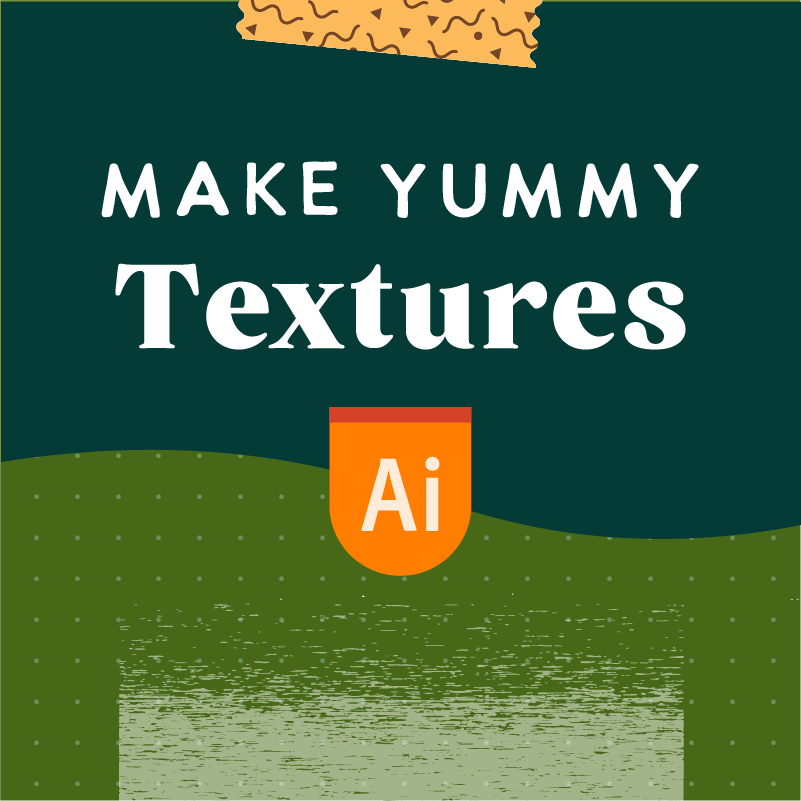How to Create Yummy Vector Textures in Adobe Illustrator
Do vector graphics have a bad rep?
As versatile as vector graphics are, they often get a bad rep for being too flat. Granted that most vector graphic styles tend to take on a look that doesn't involve too many textures like their counterpart: images or artwork created in raster-based programs like Adobe Photoshop, Procreate App on iPad, etc. But it doesn't have to be this way. It just means that artists and illustrators need to be more intentional in adding textures to the work. It doesn't always have to look like the mega grungy vintage texture from 12 centuries ago (nothing personal against grungy). An artful touch of subtle textures goes a long way.
In this tutorial, we are going to explore three easy ways to add texture using various tools and effects inside Adobe Illustrator (yep, not even having to leave the program for once. No 3rd party vector pack purchase necessary, either). The content of the post and methods introduced are largely drawn from my Skillshare class Unflat: Make Vector Textures from Scratch in Adobe Illustrator CC, where I dive deeper with a variety of different options step by step. You can grab a seat for this class for free using this linky link. Alright, let's jump right in.
window.fd('form', {formId: '6241a89043a49fb25a549975',containerEl: '#fd-form-6241a89043a49fb25a549975'});
How to Generate the Grain Textures
The most common way to add texture is using the grain texture. It is simply a layer on top of the existing shape or object. The grain textures are traditionally done with scanned images of surfaces that resemble the desired textures, but I will show you a quicker way by using the built-in grain effects from the Effect Gallery. And the best part is, that you can use the texture infinite times on different files and projects!
Step 1: Create a rectangle, say 500px by 300px or bigger. This rectangle is the base for the grain effect. You want it to be nice and big so that it's easier for Adobe Illustrator to pick up the details when we do live image trace. We color it black because it gives us the maximum amount of contrast, which is also helpful when we vectorize those details.
note: Need a refresher on how to create simple shapes in Adobe Illustrator, check out this tutorial: Adobe Illustrator For Beginners: How to Draw and Edit Basic Shapes
Step 2: Create a Black and white gradient as such. Notice that the grey transition section is going to be where the grain texture is generated in the next step.
Prefer watching a tutorial? I have just the right video for ya!
Create a vector black and white gradient
Create a vector black and white gradient
Step 3: Go to Effect > Effect Gallery > Texture (folder) > Grain. Select Stippled if you would like the classic grainy look. Adjust the sliders to your desired effect. Click OK.
apply grain texture effect
apply grain texture effect
Now we have a rectangle with the live Effect applied to it. Next up, we need to rasterize this effect and turn it into a flat image. If this is a foreign concept to you. Stay calm and follow the steps.
Step 4: Click Effect > Rasterize > OK. Now we have an image of random dots.
Effect > Rasterize
rasterized image
Step 5: Click Object > Expand Appearance. I suspect this step starts to sound Greek to beginners, fear not, keep going.
Select the image. Click Window > Image Trace to bring out the Image trace panel.
image trace panel
image trace panel
Make sure you have the Preview checked, in this way you will see a live update each time you change any settings within the panel. I also like to check "Ignore White", because we only need the dark pixels for the grainy texture.
Play with the sliders: threshold, paths, corners, and noise until you reach the desired texture.
Image Trace Panel
The creation part of texture making is done. This piece of texture with a (probably literally) million anchor points is your prized procession. Say goodbye to flat vector graphics, friends. Next, let's move on to the (more) fun part of adding texture.
About the Author
Hi, I am an illustrator and digital brush creator who loves exploring all mediums. I've had the joy of collaborating with some wonderful folks, like Cloud9 Fabrics, and MSU Broad Art Museum, and sharing some tidbits of my creative process through UPPERCASE Magazine. My heart finds joy in food and nature illustrations, and I share my creative process on my YouTube Channel and teach well-designed illustration classes on Skillshare.
Portfolio | Instagram | Pinterest | Digital Brushes | 1:1 Coaching Calls
Skip hours of sifting through generalized tutorials, and enjoy a personalized learning session with a laser focus. In a 1-on-1 session, you will receive personalized instruction on how to elevate your digital illustration to the next level based on your own artistic style and preference using Procreate, Adobe Illustrator, and Photoshop, as well as your paper sketchbook.













